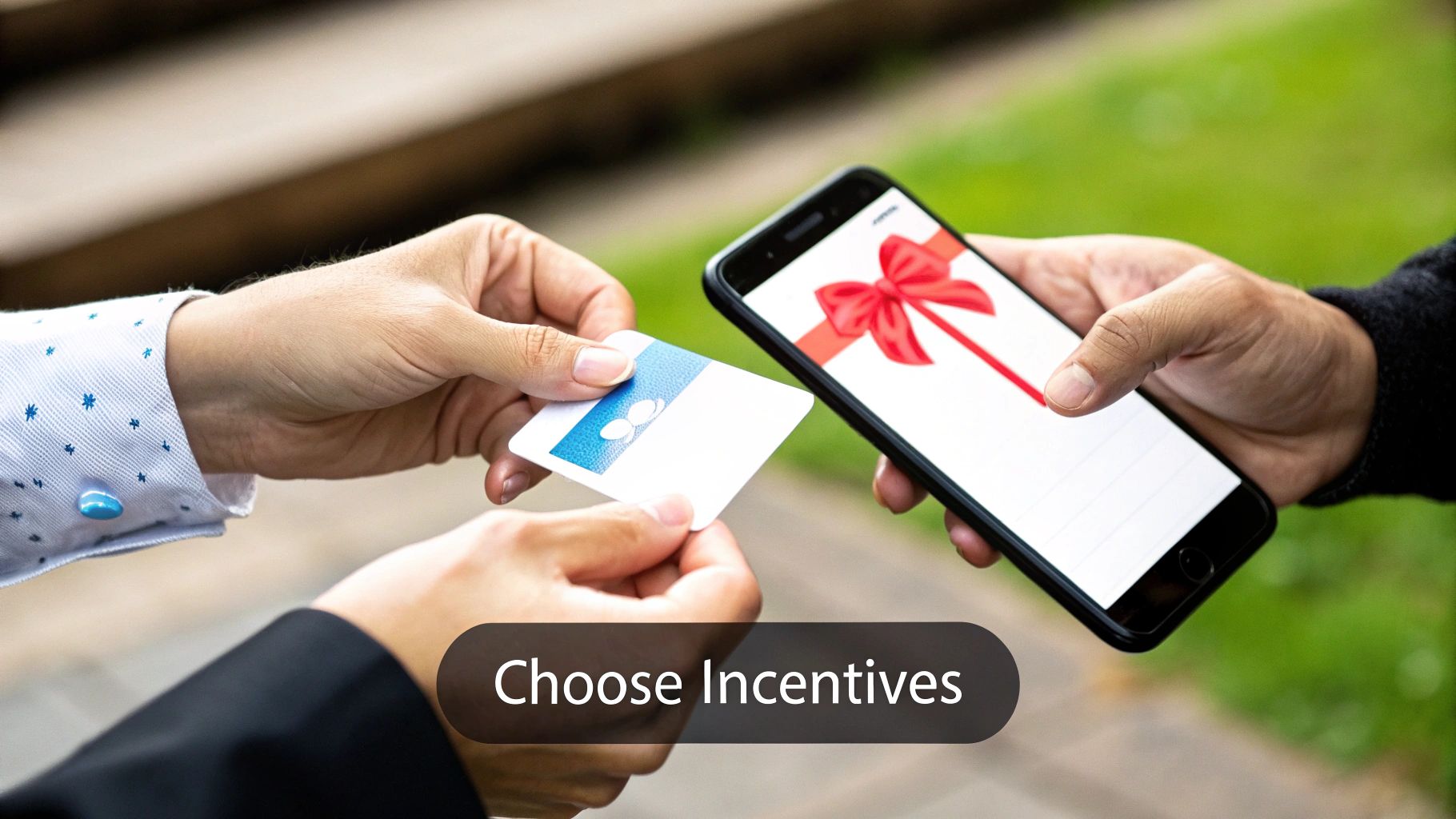Building Your Referral Program Marketing Strategy Foundation
A successful referral program isn't built on luck. It requires a solid understanding of your customers, their motivations, and effective program design. This means identifying enthusiastic customers, understanding what motivates them to share, and creating a rewarding program. The goal is to cultivate brand advocates, not just acquire customers. For further insights, check out this helpful resource: How to master referral program best practices.
Understanding the Power of Referral Marketing
Effective referral programs leverage the power of trust. Consider this: are you more likely to try a new restaurant based on an advertisement or a friend's recommendation? This principle holds true across industries. People value trusted recommendations, and this translates into tangible results.
Referral marketing consistently drives sales and customer satisfaction. According to Nielsen, 92% of consumers trust recommendations from friends and family over other advertising. This trust leads to higher conversion rates, often 3 to 5 times higher than other channels. In Asia, referral programs are particularly effective, boasting conversion rates 42% higher than other regions. This highlights the importance of referral strategies in global marketing, especially in markets where personal recommendations hold significant weight. For a deeper dive into these statistics, visit: Important Referral Marketing Stats You Need to Know.
Visualizing the Impact
The infographic below illustrates key data points related to effective referral program marketing:

Referral programs can significantly boost conversion rates. Compared to organic methods, referral programs achieve a 3% conversion rate versus 1.5% organically. These programs can also reduce customer acquisition costs (CAC) by 25% and increase participation by 50%. These results showcase the potential of referral marketing to acquire new customers and improve profitability.
Building a Scalable Framework
A scalable framework is crucial for long-term success. This means aligning your referral program with your overall business goals. For instance, if your goal is to increase customer lifetime value, your program should encourage repeat purchases from both the referrer and the referred friend. This ensures your program directly contributes to core objectives. A scalable framework should also be adaptable to future growth, allowing you to integrate new features and expand your program as your business evolves.
Let's explore how various channels contribute to referral program performance. The following table provides a comparison of conversion rates, ROI, and customer lifetime value across different referral program channels.
Referral Program Performance By Channel Comparing conversion rates and ROI across different referral program types and channels
| Channel Type | Average Conversion Rate | ROI Multiple | Customer Lifetime Value |
|---|---|---|---|
| 2.5% | 4x | $250 | |
| Social Media | 1.8% | 3x | $200 |
| In-App | 4.2% | 7x | $350 |
| Website Banner | 1.2% | 2x | $150 |
As you can see, in-app referral programs tend to have the highest conversion rates and ROI, while email and social media also contribute significantly. Website banners have lower engagement but can still play a role in a comprehensive strategy. Understanding these differences allows you to optimize your program for each channel, maximizing overall effectiveness.
Crafting Incentives That Actually Drive Referral Behavior

Generic incentives like gift cards or small percentage discounts rarely inspire genuine referral enthusiasm. To truly motivate customers to recommend your brand, you need to craft compelling incentives that resonate with their needs and values. This fosters authentic advocacy instead of forced participation. It's about understanding your audience and what truly motivates them.
Calculating Optimal Reward Values
A successful referral program hinges on finding the right balance for incentive value. A data-driven approach is key. Successful companies analyze customer lifetime value (CLTV) and profit margins to determine the optimal reward.
For instance, if the CLTV of a new customer is $500 and your profit margin is 20%, a $20 reward for both the referrer and the referred friend could be a good starting point. This balances profitability with an attractive incentive.
Thinking Beyond Monetary Rewards
While cash is a common incentive, creative non-monetary rewards can be even more effective. Think outside the box and consider options that resonate with your specific audience.
- Exclusive early access to new products or features: This is particularly attractive to early adopters and brand enthusiasts, giving them a sneak peek at what's coming next.
- Premium customer support: Offering priority access or a dedicated account manager can provide significant value and build stronger relationships.
- Branded merchandise or unique experiences: These rewards create a sense of community and exclusivity, further strengthening brand loyalty.
- Charitable donations in the referrer's name: This resonates with socially conscious customers and enhances your brand image.
These non-monetary rewards tap into intrinsic motivations, leading to deeper engagement and more genuine advocacy. They also allow for greater personalization and a more memorable experience.
Strategic Timing of Rewards
When you reward customers significantly impacts participation and satisfaction. Immediate rewards upon referral signup can boost initial engagement. However, waiting until the referred friend makes a purchase ensures higher quality referrals.
A combined approach, offering a smaller upfront reward followed by a larger reward after purchase, can be an effective strategy. This incentivizes both the initial sharing and the desired conversion.
Double-Sided vs. Single-Sided Rewards
Double-sided rewards, benefiting both the referrer and referred friend, are generally more effective. They create a win-win scenario, encouraging participation from both parties.
Single-sided rewards might be appropriate when targeting already loyal customers who are inherently motivated to share. This targeted approach maximizes the impact while minimizing costs. Careful analysis of your target audience and program goals is essential.
Testing and Optimization
Continuous testing and optimization are crucial for a successful referral program. A/B testing different incentive types, values, and timing helps identify what resonates best with your customers.
Regularly analyze program data, including participation rates, conversion rates, and CLTV of referred customers. This data-driven approach allows you to refine your incentive structure and maximize your return on investment. Refgrow offers seamless integration and detailed analytics, providing a powerful platform for implementing and optimizing your referral program.
Designing Frictionless Experiences That Encourage Sharing

A successful referral program marketing strategy depends on a smooth and enjoyable referral process. Even the most attractive incentives won't overcome a clunky sharing experience. This section explores how successful programs minimize friction, turning customer intent into tangible referrals.
Identifying and Removing Roadblocks
Many referral programs fail to reach their full potential because of unnecessary complexity. Imagine recommending a product, only to find the referral link buried deep within an email or website. This kind of friction can quickly dampen enthusiasm. Identifying these roadblocks is the first step to a seamless referral experience. Lengthy signup processes or unclear instructions can deter even the most loyal customers.
Integrating Referral Opportunities Naturally
Referral opportunities should blend seamlessly into the customer journey. Think of them as strategically placed signposts, gently guiding customers towards sharing. Here are some key touchpoints to consider:
- Post-Purchase Emails: Capitalize on the positive post-purchase experience by including a prominent referral link in thank-you emails.
- Order Confirmation Pages: Strike while the iron is hot by featuring a clear call-to-action on order confirmation pages, inviting customers to share their recent purchase.
- Dedicated Referral Pages Within User Accounts: Create a centralized hub within user accounts where customers can easily access their personal referral link and track their progress.
- In-App Notifications (For SaaS Products): Use targeted in-app notifications triggered by specific user behavior, such as completing a key action or achieving a milestone, to remind them about the referral program.
Mastering the Art of Effortless Sharing
Sharing should be as intuitive as posting on social media. The easier it is, the more likely customers are to participate.
- Pre-Populated Referral Messages: Provide ready-made messages for email and social media, minimizing the effort required from your customers.
- One-Click Social Sharing Buttons: Integrate social sharing buttons for instant sharing with a single click, maximizing social reach.
- Easy Referral Link Generation: A simple and transparent link generation process avoids confusion and frustration.
- QR Codes for Offline Sharing: Bridge the gap between offline and online referrals by incorporating QR codes into printed materials or product packaging.
Transparent Tracking Without Overwhelm
Tracking is essential for program management, but it shouldn't overwhelm the user. Think clear, concise progress bars – informative without being intrusive.
- Clear and Concise Referral Dashboards: Give referrers a user-friendly dashboard displaying their referral activity, rewards earned, and pending referrals. This provides valuable feedback without being overwhelming.
- Automated Email Notifications for Referral Updates: Keep referrers engaged and informed with automated email notifications about referral progress, such as when a friend signs up or makes a purchase.
By designing frictionless experiences and using technology effectively, your referral program marketing strategy can turn satisfied customers into brand advocates. Refgrow offers a platform to implement these strategies, providing seamless integration and robust tracking capabilities. Learn more about Refgrow's features and how they can optimize your referral program.
Leveraging Technology For Program Optimization And Scale

Modern referral program marketing strategies depend significantly on technology to create personalized customer experiences and optimize performance. This transcends basic referral tracking. It's about building a seamless and engaging experience that motivates sharing and maximizes results. This involves using technology to automate tasks, gather data, and personalize the referral process.
Automating Workflows For Efficiency
Automation is essential for scaling your referral program. Automated workflows streamline the entire referral process, from initial invitation to reward delivery. This allows your team to focus on strategic initiatives rather than manual tasks. For instance, automated emails can nurture referrers and maintain engagement throughout the referral lifecycle.
Automated Email Sequences: Triggered emails can welcome new referrers, send reminders to share their unique link, and express gratitude for successful referrals.
Referral Link Generation: Automated systems instantly create unique referral links for each participant, eliminating manual processes.
Reward Delivery: Automated reward systems ensure prompt and accurate delivery of incentives, enhancing overall customer satisfaction.
Real-Time Performance Tracking
Data-driven decisions are vital for optimizing your referral program marketing strategy. Real-time tracking provides immediate insights into program performance, allowing you to identify what's working and what needs adjustment. This facilitates agile adjustments and continuous improvement.
Referral Conversion Rates: Monitor how many referrals result in actual purchases, highlighting areas for improvement in the conversion funnel.
Customer Lifetime Value (CLTV) of Referred Customers: Evaluate the long-term value of referred customers compared to non-referred customers, showcasing the program's impact on revenue growth.
Referral Program ROI: Calculate the overall return on investment for your program, demonstrating its value to the business.
Refgrow offers seamless integration and detailed analytics to monitor these key performance indicators. This data-driven approach allows you to fine-tune your strategy and achieve optimal results. Learn more about how Refgrow streamlines tracking and reporting: Learn more about how Refgrow streamlines tracking and reporting.
Integrating With Your Marketing Stack
Your referral program shouldn't operate in isolation. Integrating it with your existing marketing stack enhances efficiency and expands reach. This creates a unified customer experience and streamlines data management.
CRM Integration: Connecting your referral program with your CRM allows for personalized communication and effective tracking of referral sources.
Email Marketing Platform Integration: Automating referral email campaigns and segmenting your audience enables targeted messaging.
Social Media Integration: Enable easy social sharing of referral links and track referrals originating from social media platforms.
Emerging Technologies: AI, Blockchain, and Gamification
A key trend in referral marketing is using emerging technologies like AI and blockchain to enhance effectiveness. AI can personalize incentives, while blockchain offers transparency. Gamification adds another layer of engagement. Learn more about the future of referral marketing: referral marketing trends for the future. By analyzing past behaviors, AI can suggest personalized incentives that motivate referrals and drive conversions. The increasing popularity of experiential rewards and gamification adds an element of fun and encourages ongoing participation, ultimately improving commercial outcomes. This focus on customer engagement boosts the lifetime value of referred customers, which is often 16% higher than that of non-referred customers.
These approaches simplify managing and optimizing your referral program marketing strategy for sustainable growth. By leveraging these technologies and focusing on a truly rewarding experience, businesses can turn satisfied customers into enthusiastic brand advocates.
Measuring What Matters For Referral Program Success
Simply counting referrals isn't enough to understand your program's performance. True success relies on analyzing the right metrics. This means moving past superficial numbers and focusing on data that indicates long-term growth and overall business impact. This section provides a framework for tracking the KPIs that truly drive success.
Key Performance Indicators (KPIs) Beyond The Basics
While the number of referrals is a good starting point, more detailed metrics provide a deeper understanding of your program’s effectiveness. These Key Performance Indicators (KPIs) offer valuable insights into how your program is actually performing. This involves examining factors like customer lifetime value, program ROI, and participation rates. You might be interested in: How to master referral marketing techniques.
Customer Lifetime Value (CLTV) of Referred Customers: This metric reveals the long-term revenue generated by customers acquired through referrals. It's essential to compare this CLTV to the CLTV of customers acquired through other channels. This comparison helps you understand the true value of your referral program.
Program ROI: Calculating the return on investment (ROI) of your referral program requires careful accounting of all associated costs, including incentives and administrative expenses. This comprehensive view gives you a clear picture of your program's profitability.
Participation Rate Analysis: Analyzing participation rates across various customer segments can reveal valuable insights. You can see which groups are most engaged with your program. This data helps you refine your targeting and optimize your efforts. For example, if one segment consistently generates more referrals, understanding what motivates them can help you replicate that success in other segments.
Implementing Effective Attribution Tracking
Understanding the entire referral journey is critical for accurate measurement. Attribution tracking maps the complete process, from the initial referral link click to the final purchase. This gives you a detailed understanding of how each referral contributes to your conversions. This detailed view is crucial for pinpointing what strategies are effective and identifying areas for improvement.
Identifying And Leveraging Your Most Valuable Advocates
Not all referrers contribute equally. By analyzing referral patterns, you can identify your most valuable advocates. These are the customers who consistently bring in high-quality referrals. Identifying these individuals allows you to nurture their engagement and learn from their successful referral strategies. This targeted approach can significantly boost your overall program performance.
Data-Driven Optimization For Continuous Improvement
Data should be the foundation of your optimization strategy. Regularly analyzing program data, including referral conversion rates and the KPIs mentioned above, provides actionable insights. This means using data to inform decisions about your incentive structure, referral process design, and overall program strategy. This data-driven approach allows you to continually refine your program for maximum impact.
Moving Beyond Vanity Metrics
Many programs focus on vanity metrics like the total number of referrals, but these numbers can be misleading. Instead, concentrate on metrics that directly affect business growth. Focus on metrics such as the CLTV of referred customers and program ROI. These metrics give a more accurate and valuable measure of long-term success.
To better understand the key performance indicators for a successful referral program, consider the following table:
Essential Referral Program KPIs And Benchmarks: Key metrics to track for referral program success with industry benchmarks and optimization targets
| Metric | Industry Average | Top Performer Benchmark | Measurement Frequency |
|---|---|---|---|
| Referral Rate | 2.3% | 5.0% | Monthly |
| Conversion Rate from Referral | 10% | 20% | Monthly |
| CLTV of Referred Customers | $250 | $400 | Quarterly |
| Referral Program ROI | 3x | 5x | Quarterly |
By monitoring these KPIs, you can effectively evaluate your program's performance, identify areas for improvement, and drive significant growth.
By tracking the right metrics, you can shift your referral program from guesswork to a data-driven engine for growth. Refgrow offers tools and analytics to measure what truly matters, allowing you to continuously improve and maximize your program’s potential. This data-driven approach sets the stage for sustained, long-term success.
Scaling Your Program For Sustainable Long-Term Growth
Once your referral program shows consistent results, scaling it effectively without compromising quality becomes the next challenge. This means broadening your program's reach, integrating it with other marketing efforts, and cultivating sustainable growth. This section will explore strategies for achieving these goals while keeping engagement high.
Expanding Program Reach Without Diluting Effectiveness
As your business expands, your referral program needs to grow with it. This involves strategically increasing its visibility to new customer segments, markets, or even product lines. However, simply increasing visibility isn't the solution. The key is maintaining effectiveness while reaching a wider audience. You might find value in resources like this: How to master top referral program ideas. This can be achieved by developing targeted campaigns for specific demographics or introducing new referral incentives aligned with different product offerings.
Integrating With Other Marketing Channels
A referral program shouldn't operate in isolation. Integrating it with your existing marketing initiatives can create synergy. This involves promoting your referral program across channels like email marketing, social media, or even in-app notifications. For instance, adding a referral call-to-action in post-purchase emails can significantly increase participation. Running social media contests around your referral program can also broaden its reach and create excitement.
Building Sustainable Growth Engines That Compound Over Time
The ultimate goal of any successful referral program marketing strategy is to create a sustainable growth engine. This means implementing strategies that not only attract new customers but also encourage repeat referrals. Tiered referral programs, where referrers earn bigger rewards based on the number of successful referrals, are a great way to achieve this. These programs motivate continued participation and transform satisfied customers into active brand advocates. This creates a network effect, where each new referral has the potential to bring in even more referrals, creating exponential growth.
Advanced Strategies For Amplifying Program Impact
Beyond the fundamentals, several advanced strategies can further amplify your program's impact. Strategic partner integrations can unlock access to entirely new customer bases. By partnering with complementary businesses, you can cross-promote each other's referral programs, expanding your reach. A fitness apparel company partnering with a nutrition brand to offer joint referral rewards is a good example.
Community building is another impactful approach. Creating a dedicated online community or forum for referral program participants creates a sense of belonging. This platform lets referrers connect, share tips, and celebrate their achievements, boosting engagement and encouraging more referrals.
Avoiding Common Scaling Pitfalls
Scaling a referral program has its challenges. One common pitfall is compromising referral quality by focusing solely on quantity. To prevent this, closely monitor referral sources and track the conversion rates of referred customers. This data can identify which channels or segments generate the most valuable referrals so you can focus your efforts there. Another common mistake is neglecting to adapt your incentive structure as the program expands. What initially motivated early adopters may not resonate with a broader audience. Regularly review and adjust your incentives based on customer feedback and program data. Continuously test different reward types and values to ensure they remain relevant to your evolving customer base. This proactive approach helps avoid stagnation and maintains long-term effectiveness.
By implementing these strategies and avoiding common scaling mistakes, you can ensure your referral marketing strategy delivers results as your business grows, resulting in sustainable, long-term growth driven by the genuine enthusiasm of your most loyal customers.
Key Takeaways
This section distills the core components of a winning referral program marketing strategy into actionable insights. It's your roadmap to building a system that fuels sustainable growth and fosters genuine customer advocacy. Whether you're launching a new program or revamping an existing one, these takeaways provide a practical framework for success.
Focus on Intrinsic Motivation
Don't just offer generic rewards. Understand what truly motivates your customers. Think beyond cash incentives and consider offering exclusive early access to products, premium customer support, or even charitable donations in their name. This fosters authentic enthusiasm and turns customers into passionate advocates. For example, if your target audience values sustainability, consider offering a tree planted for each successful referral.
Make Sharing Effortless
The easier it is to refer, the more referrals you'll get. Integrate referral opportunities seamlessly into the customer journey. Think post-purchase emails, order confirmation pages, or dedicated referral hubs within user accounts. Provide pre-populated referral messages and one-click social sharing buttons for ultimate convenience. This removes friction and encourages spontaneous sharing.
Leverage Technology for Personalization and Scale
Technology is essential for a modern referral program marketing strategy. AI can personalize incentives based on individual customer behavior, while automation streamlines processes like reward delivery and referral tracking. Real-time performance dashboards provide actionable insights, allowing you to continuously optimize for maximum impact.
Measure What Matters: Beyond Vanity Metrics
Don't just count referrals. Analyze the data that truly matters. Focus on key performance indicators (KPIs) like customer lifetime value (CLTV) of referred customers, program ROI, and participation rate analysis across different customer segments. This data-driven approach allows you to understand the true impact of your program and make informed decisions. For instance, tracking the CLTV of referred customers can reveal whether they are more valuable in the long run than customers acquired through other channels.
Build a Scalable and Sustainable Program
Design your program for long-term growth. As your business expands, your referral program needs to scale with it. Implement tiered referral programs that reward increasing engagement. Explore strategic partner integrations to access new customer bases. This creates a compounding effect where your program grows organically alongside your business.
Key Action Items for Your Referral Program
Analyze Your Customer Base: Understand their needs, values, and motivations to tailor effective incentives. Timeline: Complete within 1 week. Troubleshooting: Use surveys and customer feedback forms to gather data.
Optimize the Referral Process: Eliminate friction points and ensure a smooth, user-friendly experience. Timeline: Ongoing optimization. Troubleshooting: Conduct user testing to identify pain points.
Implement Tracking and Analytics: Monitor key metrics to measure performance and identify areas for improvement. Timeline: Set up tracking within 2 weeks. Troubleshooting: Use a dedicated referral program platform like Refgrow for comprehensive analytics.
Promote Your Program: Actively promote your program across various channels to reach your target audience. Timeline: Ongoing promotion. Troubleshooting: Experiment with different marketing strategies to find what works best.
By implementing these key takeaways, you can create a powerful referral program marketing strategy that drives measurable results and builds a loyal community of brand advocates.
Ready to transform your customer base into a growth engine? Refgrow offers a seamless, embeddable platform designed specifically for SaaS businesses to launch and scale their referral programs effortlessly. Start driving growth through referrals today.

